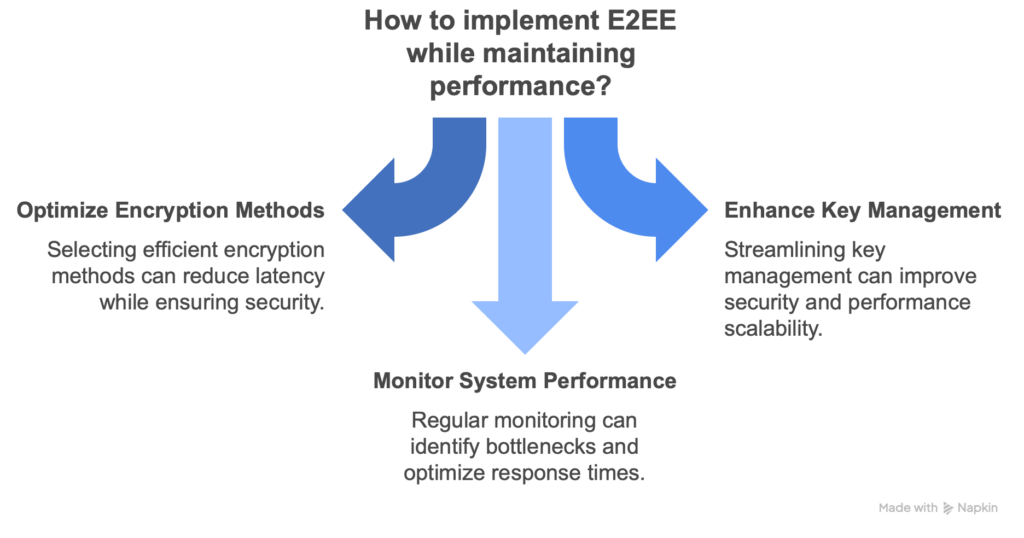Table of Contents

End-to-end encryption (E2EE) ensures your text input stays private and secure from the moment you type until it reaches the intended recipient. Here’s how it works and why it matters:
- Instant Encryption: Every keystroke is encrypted immediately, turning your text into unreadable data.
- Key Management: Devices use unique encryption keys, updated regularly to prevent breaches.
- Device-Based Security: Encrypting on your device keeps data private, even offline, and protects against threats like keyloggers.
- Industry Standards Compliance: E2EE helps meet strict regulations in healthcare, finance, and cybersecurity.
- User Trust: Strong encryption reassures users their sensitive data is safe.
E2EE Text Input Protection Methods
End-to-end encryption (E2EE) secures text input with multiple layers of encryption. Below, we cover its key components, focusing on how encryption keys are managed and how each step in the process protects your keystrokes.
Managing Encryption Keys
Key management is a cornerstone of secure text input in E2EE systems. Each device generates a unique pair of public and private keys. The public key encrypts the data, while the private key stays securely stored on the device.
To strengthen security, modern keyboard SDKs use key rotation practices. These ensure encryption keys are updated regularly, reducing the risk of breaches. For example, Fleksy’s In-App Keyboard SDK applies these techniques to protect the data of over 20 million users [1].
How Text Encryption Works
The encryption process involves several clear steps:
- Initial Encryption: Each keystroke is encrypted the moment it’s pressed.
- Data Transformation: The characters are turned into encrypted packets.
- Secure Transmission: These packets are sent through protected channels.
- Recipient Decryption: Only the intended recipient can decode the message.
Device vs. Server Encryption
The choice between encrypting data on the device or on a server has major implications for security:
| Feature | Device-Based Encryption | Server-Based Encryption |
|---|---|---|
| Where Processing Happens | On the device | On remote servers |
| Network Dependency | Works offline | Requires a connection |
| Speed | Instant | Depends on network |
| Privacy | High | Varies by setup |
| Resource Usage | Uses device resources | Relies on server power |
Device-based encryption stands out for its privacy and offline functionality. By keeping data local, it ensures consistent security, even when working across different languages [1].
This approach also shields against threats like keyloggers and identity theft, making it essential for apps that handle sensitive data. Even a brief security lapse can expose user information, so robust encryption at the device level is critical [1].
E2EE Benefits for Keyboard SDKs
Building on the encryption methods discussed earlier, these points explain why E2EE is crucial for secure keyboard SDKs.
Protecting Data Privacy
E2EE ensures keystrokes remain secure, blocking breaches and unauthorized access. When applied to keyboard SDKs, it creates a safe space where every keystroke stays private from the moment it’s typed. The encryption process shields user data with multiple security layers, even covering integrated features like autocorrection and next-word prediction. This level of privacy also helps meet strict regulatory requirements.
Aligning with Industry Standards
E2EE doesn’t just protect data – it helps keyboard SDKs comply with rigorous industry regulations. This is especially critical in sectors like:
| Industry | Security Requirement | Purpose |
|---|---|---|
| Healthcare | HIPAA compliance | Safeguards patient information during text input |
| Finance | PCI DSS requirements | Secures banking details and financial transactions |
| Cybersecurity | SOC 2 certification | Reduces risks from cyber threats and breaches |
Real-world examples highlight its advantages. For instance, a Leading European Bank used secure keyboard technology to improve its mobile banking app.
Boosting User Trust
Strong encryption reassures users that their privacy is protected. When users trust that their keystrokes are secured by E2EE, they feel more comfortable using the app for sensitive tasks. This confidence leads to higher user retention and increased usage, particularly in scenarios involving confidential data.
With over 20 million users relying on encrypted keyboard solutions [1], E2EE continues to meet expectations for privacy and security.
Adding E2EE to Keyboard SDKs
Selecting Encryption Methods
For encrypting keystroke data, use strong symmetric encryption techniques. Combine this with asymmetric encryption for secure key exchange. To ensure data integrity, apply hash functions and implement regular key rotation to enhance security.
Key Security Best Practices
Generate session-specific keys using cryptographically secure random number generators. Protect these keys by following these methods:
- Storage: Use tools like hardware security modules (HSMs), trusted platform modules (TPMs), or platform-specific options such as Android Keystore and iOS Keychain.
- Distribution: Implement key exchange protocols that ensure perfect forward secrecy, so even if keys are compromised, past communications remain secure.
Once your key management strategy is solid, these measures can be seamlessly integrated using the Fleksy SDK.
Fleksy SDK Integration Steps

With encryption methods and key practices in place, Fleksy’s In-App Keyboard SDK simplifies secure integration across multiple platforms. Here’s how the integration process works:
| Integration Phase | Security Feature | Implementation Goal |
|---|---|---|
| Initial Setup | Keylogger Prevention | Prevent unauthorized keystroke capture |
| Core Integration | Malware Protection | Block malicious code injection |
| Custom Configuration | Data Encryption | Safeguard all text input data |
The SDK’s security infrastructure supports offline functionality and ensures consistent encryption standards across platforms like iOS, Android, Unity, and Linux.
Up next, we’ll explore the performance and scalability challenges tied to E2EE integration.
E2EE Implementation Issues

When it comes to encryption techniques and integration, tackling implementation challenges is a key part of the process.
Speed and Performance
Adding E2EE can sometimes slow down response times due to the extra work involved in encrypting data. Developers need to find a way to maintain strong security while keeping latency low. Choosing the right encryption methods and ensuring smooth key management are critical to achieving this balance.
Key Management Solutions
Key management plays a big role in both security and performance. The Fleksy SDK simplifies key distribution and storage while solving issues like secure key transmission, protecting keys in device memory, and managing who has access to them.
These solutions make it possible to scale secure text input without sacrificing performance.
Growth and Scale
As more users adopt the system, keeping E2EE running smoothly requires a scalable setup. This includes fine-tuning key management and monitoring systems to handle increasing demands. Fleksy has developed infrastructure that supports growth while maintaining both speed and security [1].
Conclusion
E2EE plays a key role in ensuring secure text input, especially as apps deal with more sensitive user data. Incorporating strong E2EE into keyboard SDKs offers essential protection against risks like keyloggers, malware, and identity theft.